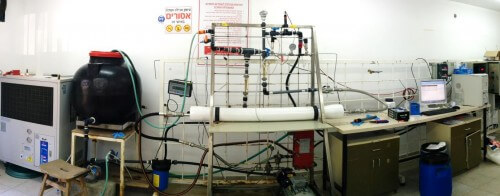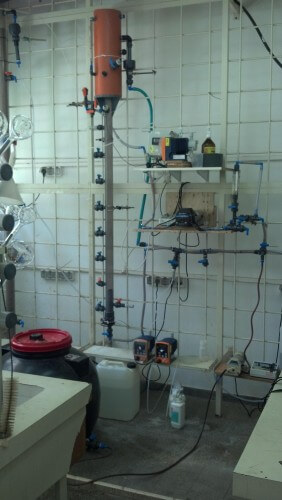In the lab of Prof. Uri Lahav at the Technion, methods are being developed that will allow desalination of seawater in a more efficient and economical way. Laboratory visit

By: Tal Goldert, Angle - Science and Environment News Agency
After we anxiously watched Barnana Raz dry up, saved on showers and dried the lawns, the desalination plants arrived and changed the picture of the water sector in Israel.
In Israel there is a constant shortage of natural water, so the desalination solution is already used today, and will be used even more in the future, an important and central source of water for a variety of uses. According to the water authority's plans, the amount of desalinated water by the end of 2015 will be 600 million cubic meters per year, and this is when water consumption for domestic, public and industrial uses is estimated at 800 million cubic meters. This means that the benign (drinkable) water system relies on the desalination facilities to the extent of about 75 percent, and the water system that includes agricultural irrigation is based on 30-40 percent desalinated water.
Under our noses, the State of Israel has become a desalination empire, opening up to researchers whole worlds of applied challenges, focused on improving the performance of desalination systems, their energy efficiency and the main goal - to succeed in producing more desalinated water from each cubic meter of seawater, with as little energy as possible.
The price of desalination
Although water and electricity do not go well together, we must not forget that producing water consumes electricity, and a lot of it. Pumping benign water and transporting it throughout the State of Israel consumes, according to the data of the Electric Company and the Ministry of Energy, close to six percent of the national electricity consumption, through sources, water corporations and local authorities. The desalination process itself also has an energy cost, which is 3.5 kWh (kilowatt hour) per cubic meter, or in other words - a consumption of 2,100 gigawatt hours per year, which is an additional four percent of the annual electricity consumption in Israel. There are desalination facilities, such as the one in Ashkelon, for which a power plant was built especially to supply electricity only to them.
The already heavy burdens imposed on the energy economy of the State of Israel require a constant search for solutions for energy efficiency of the process and a reduction in its energy consumption, so that we can enjoy a lot of water, but not at the expense of damage to the environment that may be caused by increased electricity production.
Beyond domestic and commercial uses, water in Israel is also diverted for irrigation and agricultural use. A key source of water for this sector is the settled wastewater: wastewater (sewage and industrial waste) that has undergone a purification process until it is suitable for irrigating agricultural areas. The State of Israel is the world champion in the rate of wastewater reclamation, and 75 percent of its wastewater is purified and diverted for reuse, most of it for agricultural use. As the use of effluents in the agricultural sector increases, more benign water can be diverted to the domestic sector, and the Water Authority intends to continue developing effluent reclamation plants for agriculture, so that their volume by 2020 will be 600 million cubic meters per year.
The route of water use in the State of Israel, then, looks like this:

Any change in the composition between benign water and desalinated water, of course, affects the domestic consumer, but it is important to remember that it also continues to affect the agricultural consumer, who is thirsty for water at the end of the chain.
In the research laboratory of Prof. Uri Lahav, in the Faculty of Agricultural and Civil Engineering at the Technion, several generations of students have been engaged in a variety of studies aimed at optimizing the desalination process, and getting water from the other end of the pipe that will be of good enough quality not only for drinking, but also for irrigation that will arrive in their next incarnation. After the sewage treatment institute.
Oranges do not like boron
One of the elements found naturally in seawater, and easily treated to make it suitable for drinking water, is boron. Boron is a chemical element found naturally in a relatively low concentration in seawater, and its concentration is reduced to about a third in a normal desalination process. It is not harmful to human health except in high concentrations, but it causes damage to the structure of the soil, and is even directly harmful to some crops, especially citrus fruits, whose sensitivity starts from a very low concentration of boron.

In order to avoid the negative effects that boron may have after it reaches the irrigation systems with the water, a way must be found to effectively separate it from the seawater already in the desalination process. This can be done using two main methods. One method, the one currently carried out in the desalination facilities in Israel, is by additional filtration in the desalination facility, which of course entails an increase in the energy consumption of the entire desalination process. The second method, tested in the present study, is based on the removal of boron in a single filter. This method is based on the conditions in which the water is desalinated - mainly its pH value.
In a series of previous studies, the researchers in the laboratory defined a mathematical model that characterizes the desalination process and the efficiency of boron removal (as part of Dr. Oded Nir's doctoral thesis at the Technion), Liron Ofek, a researcher who is currently working on her master's degree, is developing a new operational approach that combines advantages in all fields. A series of chemical and engineering operations (lowering the buoyancy value of the water, which leads to a chemical process of breaking down minerals from the water and the emission of carbon dioxide, and subsequently raising the buoyancy value beyond the original value in seawater) allows for careful filtering of the water without the sedimentation of minerals, which cause the clogging of the filters This enables filtration while reducing energy consumption, and lowering the cost of desalination.
"As soon as the sedimentation limit on the membrane (filter) was removed while removing sufficient boron, we were able to use membranes characterized by a higher water flux. When more water enters the system, the recovery ratio can be increased - that is, more clean water can be produced from each cubic meter of seawater, with less energy," Ofek explains. "All over the world they are researching and trying to optimize and cheapen the process. The process proposed by us makes it possible to reduce energy consumption by about ten percent (7 cents per cubic meter of product), and with the volumes of desalination that exist today in the world, this is very significant."
It is worth noting that the method developed so far is suitable for many places in the world, but not for Israel. The requirements of the Israeli standard to significantly lower the concentration of salts derives from the use of the water for irrigation, so the research group is now working on completing the process so that it also meets the requirements in Israel.
My trash is your resource
Another substance that is abundant in seawater and may be a sought-after resource is magnesium, which is removed in the desalination process and is found in high concentration in the brine left behind. The magnesium in this brine can be used as a cheap and available source for the processes of creating a phosphorous/nitrogen fertilizer that has been produced in recent years from household drains and is called struvite. To precipitate strobe from domestic wastewater, magnesium must also be added to it, and the common production method is to add an expensive magnesium chemical to precipitate it.
The researchers showed that magnesium can be selectively separated from seawater through a process called nanofiltration. The magnesium can be added at a later stage to the wastewater, almost without the addition of unwanted salts, and thus they can be used further down the road for agricultural irrigation. With the innovative method developed by the researchers, the strobe fertilizer production process can be significantly reduced (tens of percent), as a result of the use of magnesium derived from seawater (or the concentrate produced in seawater desalination facilities) and not an expensive external chemical.
The ability to use the resources that exist in seawater and are already separated in the desalination processes significantly lowers the production of strobes, and enables maximum exploitation of the chemical potential inherent in seawater.
The next challenge: the warm sea
The research group is already busy with the following challenges - examining the effect of seawater temperature on boron removal in the desalination process and the implications of the method for planning a second desalination stage, in places where it will be required (for example in Israel). "Mediterranean waters are known for very high temperature fluctuations - 14 degrees in winter and 31 degrees in summer," says Ofek. "These differences have a significant effect on the process, and in particular on the boron concentrations obtained in the product, to the extent that in the summer the desalination facilities are forced to change the operating conditions of the facilities in order to meet the desired concentrations." The team strives to define the optimal conditions for operating the facility at any temperature, so that the goals are achieved - with maximum recovery, and minimum energy.
